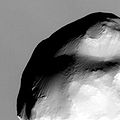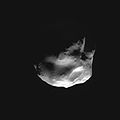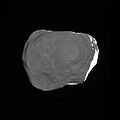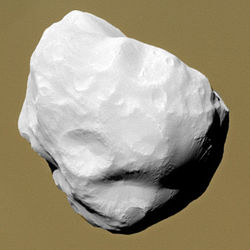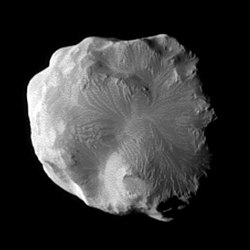Helene (Mond)
| Helene | |
|---|---|
 | |
| Saturnmond Helene vor dem Saturn, aufgenommen von der Raumsonde Cassini-Huygens | |
| Vorläufige oder systematische Bezeichnung | Saturn XII, S/1980 S 6 |
| Zentralkörper | Saturn |
| Eigenschaften des Orbits[1] | |
| Große Halbachse | 377.420[2] km |
| Exzentrizität | 0,0071[2] |
| Periapsis | 374.740 km |
| Apoapsis | 380.100 km |
| Bahnneigung zum Äquator des Zentralkörpers | 0,0° |
| Umlaufzeit | 2,737 d |
| Mittlere Orbitalgeschwindigkeit | 10,03 km/s |
| Physikalische Eigenschaften[1] | |
| Albedo | 0,7 |
| Scheinbare Helligkeit | 18,4[3] mag |
| Mittlerer Durchmesser | 35,2[2] (44 × 38 × 26)[1] km |
| Masse | 1,139 × 1016[2] kg |
| Oberfläche | 3.893[2] km2 |
| Mittlere Dichte | 0,5[3] g/cm3 |
| Fallbeschleunigung an der Oberfläche | 0,002 m/s2 |
| Fluchtgeschwindigkeit | 9 m/s |
| Entdeckung | |
| Entdecker | Pierre Laques, Jean Lecacheux |
| Datum der Entdeckung | 1. März 1980 |
Helene (auch Saturn XII) ist ein kleiner Mond des Planeten Saturn.
Entdeckung
Helene wurde am 1. März 1980 von den Astronomen Pierre Laques und Jean Lecacheux am Observatorium auf dem Pic du Midi in den französischen Pyrenäen entdeckt. Sie erhielt zunächst die vorläufige Bezeichnung S/ 1980 S 6. 1988 wurde sie offiziell nach Helena von Troja benannt, einer Enkelin des Kronos, dem in der römischen Mythologie Saturn entspricht.[4]
Bahndaten
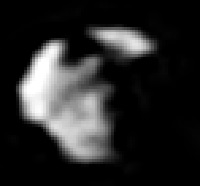
Helene umkreist Saturn in einem mittleren Abstand von 377.420 km in 65 Stunden und 41 Minuten. Die Bahn weist eine Exzentrizität von 0,0071 auf und ist 0,0° gegenüber der Äquatorebene des Saturn geneigt.
Sie ist einer von zwei kleinen Monden auf der Bahn des großen Monds Dione. Helene läuft Dione in einem Winkelabstand von 60° im führenden Lagrangepunkt L4 voraus. Im folgenden Lagrangepunkt L5 läuft der Mond Polydeuces Dione im Winkelabstand von 60° hinterher.
Bevor sie ihren offiziellen Namen erhielt, wurde Helene üblicherweise als „Dione B“ bezeichnet.
Aufbau und physikalische Daten
Helene ist ein unregelmäßig geformter Körper mit einer Ausdehnung von 44 × 38 × 26 km. Ihre geringe Dichte von 0,5 g/cm3 weist darauf hin, dass sie überwiegend aus Wassereis sowie geringen Anteilen an silikatischem Gestein zusammengesetzt ist.
Helene umläuft Saturn in 2 Tagen 17 Stunden und 41 Minuten. Sie besitzt eine helle Oberfläche mit einer Albedo von 0,7, d. h., 70 % des eingestrahlten Sonnenlichts werden reflektiert. Von der Erde aus gesehen ist sie mit einer scheinbaren Helligkeit von 18,4m ein äußerst lichtschwaches Objekt.
Galerie
- Helene, aufgenommen durch Cassini am 20. Juli 2007 aus 40.211 km Entfernung.
- Helene, aufgenommen durch Cassini am 24. November 2008 in 68.000 km Entfernung
- Nahaufnahme von Helene, aufgenommen durch Cassini am 3. März 2010.
- Helene, aufgenommen durch Cassini am 3. März 2010.
- Helenesichel, aufgenommen durch Cassini am 3. März 2010
- Helene, aufgenommen durch Cassini am 31. Januar 2011 aus 31.000 km Entfernung.
- Hemisphäre von Helene, aufgenommen durch Cassini am 18. Juni 2011.
Weblinks
- IAUC 3457: Saturn 6. März 1980 (Entdeckung)
- IAUC 3872: Satellites of Jupiter and Saturn 30. September 1983 (Nummerierung)
- IAUC 4609: Satellites of Saturn and Uranus 8. Juni 1988 (Nummerierung und Benennung)
Einzelnachweise
- ↑ a b c David R. Williams: Saturnian Satellite Fact Sheet. In: NASA.gov. 17. Februar 2023, abgerufen am 2. November 2023 (englisch).
- ↑ a b c d e Helene – By the numbers. In: NASA.gov. Archiviert vom am 2. Juni 2022; abgerufen am 2. November 2023 (englisch).
- ↑ a b Ryan S. Park: Planetary Satellite Physical Parameters. In: NASA.gov. 19. Februar 2015, archiviert vom am 4. September 2021; abgerufen am 2. November 2023 (englisch).
- ↑ Cassini Solstice Mission – About Saturn & Its Moons: Helene ( vom 21. April 2014 im Internet Archive), NASA
| weiter innen | Saturnmonde Große Halbachse | weiter außen |
| Dione | Helene 377.400 km | Polydeuces |
Auf dieser Seite verwendete Medien
N00152209.jpg was taken by Cassini on March 03, 2010 and received on Earth March 03, 2010. The camera was pointing toward HELENE, and the image was taken using the CL1 and CL2 filters. This image has not been validated or calibrated. A validated/calibrated image will be archived with the NASA Planetary Data System in 2011.
The original NASA image has been modified by cropping, centering the moon, doubling the linear pixel density, lightening shadows, increasing midtone contrast and removal of a dust artifact.Raw Narrow Angle Camera image of Helene. Taken by Cassini-Huygens on July 20, 2007 from 40,211 km with clear filters. Adapted from source image (cropped and contrast adjusted).
The small moon Helene (33 kilometers, 21 miles across) leads Dione by 60 degrees in the moons' shared orbit. Helene is a "Trojan" moon of Dione, named for the Trojan group of asteroids that orbit 60 degrees ahead of and behind Jupiter as it circles the Sun.
The image was taken in visible light with the Cassini spacecraft narrow-angle camera on Nov. 24, 2008 at a distance of approximately 68,000 kilometers (42,000 miles) from Helene and at a Sun-Helene-spacecraft, or phase, angle of 30 degrees. Image scale is 408 meters (1,338 feet) per pixel.
The Cassini Equinox Mission is a joint United States and European endeavor. The Jet Propulsion Laboratory, a division of the California Institute of Technology in Pasadena, manages the mission for NASA's Science Mission Directorate, Washington, D.C. The Cassini orbiter was designed, developed and assembled at JPL. The imaging team consists of scientists from the US, England, France, and Germany. The imaging operations center and team lead (Dr. C. Porco) are based at the Space Science Institute in Boulder, Colo.
For more information about the Cassini Equinox Mission visit http://ciclops.org, http://www.nasa.gov/cassini and http://saturn.jpl.nasa.gov.
The original NASA image has been modified by cropping, doubling the linear pixel density and sharpening.This raw, unprocessed image of Saturn's moon Helene was taken by Cassini on 18. Juni 2011 and received on Earth 20. Juni 2011.
Helene is a trojan moon of Dione. It leads Dione by 60 degrees in their shared orbit. The view looks toward the leading hemisphere of Helene (33 kilometers, 21 miles across). North on Helene is towards the top.
The camera was pointing toward Helene, and the image was taken using the CL1 and CL2 filters. The image has not been validated or calibrated. A validated/calibrated image will be archived with the Planetary Data System in 2012.
The Cassini Solstice Mission is a joint United States and European endeavor. The Jet Propulsion Laboratory (JPL), a division of the California Institute of Technology in Pasadena, manages the mission for NASA's Science Mission Directorate, Washington, D.C. The Cassini orbiter was designed, developed and assembled at JPL. The imaging team consists of scientists from the US, England, France, and Germany. The imaging operations center and team lead (Dr. C. Porco) are based at the Space Science Institute in Boulder, Colorado.
For more information about the Cassini Solstice Mission visit http://ciclops.org, http://www.nasa.gov/cassini and http://saturn.jpl.nasa.gov.
The original NASA image has been modified by cropping, sharpening and lightening shadows.N00152248.jpg was taken by Cassini on March 03, 2010 and received on Earth March 03, 2010. The camera was pointing toward HELENE, and the image was taken using the RED and CL2 filters. This image has not been validated or calibrated. A validated/calibrated image will be archived with the NASA Planetary Data System in 2011.
The original NASA image has been modified by cropping and doubling the linear pixel density.This image of Helene was acquired by the Voyager 2 spacecraft on August 25, 1981.
A photo taken by the Cassini spacecraft showing Saturn's moon Helene with the atmosphere of the planet in the background. The image was taken in visible light with the Cassini spacecraft narrow-angle camera. The view was acquired at a distance of approximately 19,000 kilometers (12,000 miles) from Helene.
Cassini imaged the surface of Saturn's moon Helene as the spacecraft flew by the moon on Jan. 31, 2011.
This small moon leads Dione by 60 degrees in the moons' shared orbit. Helene is a "Trojan" moon of Dione, named for the Trojan asteroids that orbit 60 degrees ahead of and behind Jupiter as it circles the Sun. See PIA12723 for an earlier, closer view.
This view looks toward the leading hemisphere of Helene (33 kilometers, 21 miles across). North on Helene is up and rotated 2 degrees to the left.
The image was taken with the Cassini spacecraft narrow-angle camera using a combination of spectral filters sensitive to wavelengths of polarized green light centered at 617 and 568 nanometers. The view was obtained at a distance of approximately 31,000 kilometers (19,000 miles) from Helene and at a Sun-Helene-spacecraft, or phase, angle of 65 degrees. Scale in the original image was 187 meters (612 feet) per pixel. The image was contrast enhanced and magnified by a factor of 1.5 to enhance the visibility of surface features.
The Cassini Solstice Mission is a joint United States and European endeavor. The Jet Propulsion Laboratory, a division of the California Institute of Technology in Pasadena, manages the mission for NASA's Science Mission Directorate, Washington, D.C. The Cassini orbiter was designed, developed and assembled at JPL. The imaging team consists of scientists from the US, England, France, and Germany. The imaging operations center and team lead (Dr. C. Porco) are based at the Space Science Institute in Boulder, Colo.
For more information about the Cassini Solstice Mission visit http://ciclops.org, http://www.nasa.gov/cassini and http://saturn.jpl.nasa.gov.
The original NASA image has been modified by cropping, doubling the linear pixel density, sharpening, lightening shadows and increasing contrast.This raw, unprocessed image of Helene was taken by Cassini on March 3, 2010.
The image was taken in visible light with the Cassini spacecraft wide-angle camera. The view was acquired at a distance of approximately 1,900 kilometers (1,200 miles) from Helene. Image scale is 235 meters (770 feet) per pixel.
The Cassini Equinox Mission is a joint United States and European endeavor. The Jet Propulsion Laboratory, a division of the California Institute of Technology in Pasadena, manages the mission for NASA's Science Mission Directorate, Washington, D.C. The Cassini orbiter was designed, developed and assembled at JPL. The imaging team consists of scientists from the US, England, France, and Germany. The imaging operations center and team lead (Dr. C. Porco) are based at the Space Science Institute in Boulder, Colo.
For more information about the Cassini Equinox Mission visit http://ciclops.org, http://www.nasa.gov/cassini and http://saturn.jpl.nasa.gov.
The original NASA image has been modified by cropping, doubling the linear pixel density and reducing midtone contrast. These edits were made to center the feature of interest, remove excess black background and bring out detail which is hard to see in the small original.

